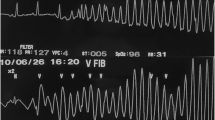Abstract
A neonate who had presented with sustained irregular heart rate during labor was found to have QT prolongation and repetitive polymorphic ventricular tachycardia (torsades de pointes) postnatally. Propranolol and propafenone successfully controlled the ventricular arrhythmias. Follow-up electrocardiograms and Holter records show persistent QT prolongation, bizarre T waves, and intermittent episodes of T wave alternans. On propranolol monotherapy the boy is thriving and completely free of ventricular arrhythmias. In the rate case of long QT syndrome in the neonate, early detection and therapy are mandatory to prevent ventricular arrhythmias and sudden death.
Similar content being viewed by others
References
Carter MC (1993) Present-day performance qualities of cardiotocographsBr J Obstet Gynoecol 100 [Suppl 9]:10–14.
Curran M, Atkinson D, Timothy K, et al (1993) Locus heterogeneity of autosomal dominant long QT syndrome.J Clin Invest 92:799–803
Garson A Jr, Dick M, Fournier A, et al (1993) The long QT syndrome in children: an international study of 287 patients.Circulation 87:1866–1872
Kron J, Oliver RP, Norsted S, Silka MJ (1990) The automatic implantable cardioverter-defibrillator in young patientsJ Am Coll Cardiol 16:896–902
Moss AJ, Liu JE, Gottlieb S, et al (1993) Efficacy of permanent pacing in the management of high-risk patients with long QT syndrome.Circulation 84:1524–1529
Müller KD, Jakob H, Neunzer J, et al (1993)123I-Metaiodobenzylguanidine scintigraphy in the detection of irregular regional sympathetic innervation in long QT syndrome.Eur Heart J 14: 316–325
Nador F, Beria G, De Ferrari GM, et al (1991) Unsuspected echocardiographic abnormality in the long QT syndrome: diagnostic, prognostic, and pathogenetic implications.Circulation 84:1530–1542
Schwartz PJ, Montemerlo M, Facchini M, et al (1982) The QT interval throughout the first 6 months of life: a prospective study.Circulation 66:496–501.
Schwartz PJ, Moss AJ, Vincent GM, Grampton RS (1993) Diagnostic criteria for the long QT syndrome: an update.Circulation 88:782–784
Southall DP, Richards J, Mitchell P, et al (1980) Study of cardiac rhythm in healthy newborn infants.Br Heart J 43:14–20.
Villain E, Levy M, Kachaner J, Garson A Jr (1992) Prolonged QT interval in neonates: benign, transient, or prolonged risk of sudden death.Eur Heart J 124:194–197.
Westgate J, Harris M, Curnow JSH, Greene KR (1992) Randomised trial of cardiotocography alone or with ST waveform analysis for intrapartum monitoring.Lancet 340:194–198.
Author information
Authors and Affiliations
Rights and permissions
About this article
Cite this article
Mache, C.J., Beitzke, A., Haidvogl, M. et al. Perinatal manifestations of idiopathic long QT syndrome. Pediatr Cardiol 17, 118–121 (1996). https://doi.org/10.1007/BF02505096
Issue Date:
DOI: https://doi.org/10.1007/BF02505096




